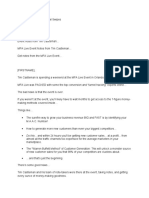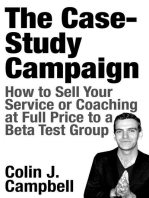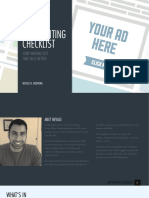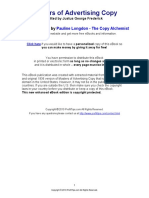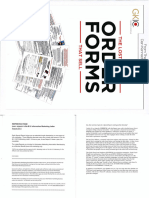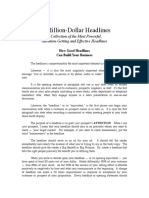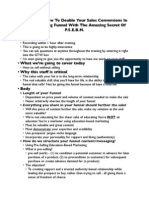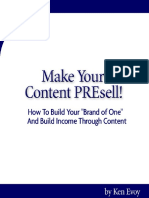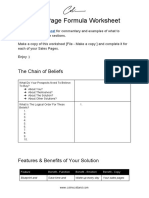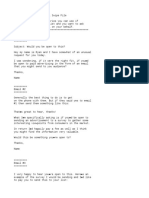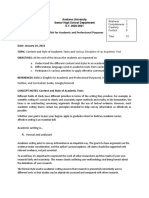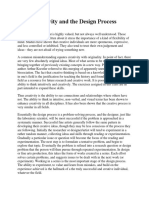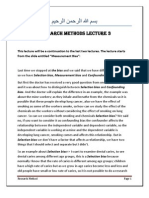Course Name:Advertising Gurus Secrets
Course Name:Advertising Gurus Secrets
Uploaded by
innerconnectionsCopyright:
Available Formats
Course Name:Advertising Gurus Secrets
Course Name:Advertising Gurus Secrets
Uploaded by
innerconnectionsOriginal Title
Copyright
Available Formats
Share this document
Did you find this document useful?
Is this content inappropriate?
Copyright:
Available Formats
Course Name:Advertising Gurus Secrets
Course Name:Advertising Gurus Secrets
Uploaded by
innerconnectionsCopyright:
Available Formats
Course Name:Advertising Gurus Secrets
Todays Topic: Lesson 1: Advertising Greats
Lesson1: Advertising Greats
Welcome This e-course, delivered to your e-mail box every day, is jam-packed with "killer" information from past marketing legends and masters. We guarantee that each one will be so full of value, so full of hints, tips and resources to help you create your own great marketing products that you won't want to wait for your next one to arrive. Nearly all the top marketers of today actually found their ideas from books written nearly 100 years ago. Why? Because all the top marketers understand what makes people buy. They understand that human nature just hasn't changed over time. Human beings will continue to be sold by the same emotions that have been used since the days of Caesar. The same things that made people buy 10,000 years ago will continue to work 10,000 years from now. These principles just do not change, human emotions never change. Of course, the Internet wasn't around 100 years ago, but direct marketing was, and the principles are exactly the same. We're going to take you on a tour from the very beginning of modern advertising right up to recent times and along the way we'll introduce you to some giants of the past and highlight some of the incredible resources that they produced. Resources that all the top marketers of today have in their libraries. Any top marketer today could tell you the secret principles of their success. But will they? You don't have to try and cajole others to give up their secrets (if you know anyone) because you will get a thorough guide right here. We hope that you use them enjoy it. Let's begin our tour in 1904 with the story of a young, confident copywriter called John E. Kennedy. It was early one May evening, the
former Canadian mounted policeman, Kennedy, sent a note to the head of advertising agency Lord and Thomas. This is what the note said: "I'm in the saloon downstairs, I can tell you what advertising is. I know you don't know. It will mean much to me to have you know what it is and it will mean much to you. If you wish to know what advertising is, send the word "yes" down by the bell boy. Signed - John E. Kennedy. A.L. Thomas, the head of Lord and Thomas, dismissed the note as arrogance. But his junior partner, Albert Lasker, spotted it and it struck a chord with him. He summoned Kennedy to his office that same night. And what Kennedy revealed changed the face of advertising - forever. He said: "Advertising is Salesmanship-in-Print." A definition that no-one has been able to better to this day. Kennedy was subsequently hired and became the highest paid copywriter of his day ($52,000 a year, a phenomenal amount in those days). Lasker got Kennedy to write all of his principles into a series of lessons called "The Book of Advertising Tests." Lord and Thomas utilised these and became the training centre for all copywriters. In 1912 his book of Ad tests was republished as the very popular "Reason Why Advertising". If you stop to think about it, what a great title that was. It's only natural that you should give a prospect a reason to buy. But lots of advertisers, even today, do not. They merely say: "Buy my product." They are making the big mistake of not explaining: "Buy my product because......" Are you making these mistakes with your marketing? It's important not to lose focus on why we market our products and services. All the past masters (and present ones) agree on one thing here. We market because we need to make sales and hence a profit. John W. Blake in his book: "Blind Advertising Expenditure" wrote: "there is only one justification for advertising. Sales! Sales! Sales!" And Claude Hopkins wrote: "Your Marketing only works if it actually sells." Think about it. What's the point of having sexy looking web-sites or graphically designed sales letters if they don't convert prospects into customers. Who are you trying to impress? You need sales. And by the time you finish this e-course you will come to realise, if you don't already, that it's words that will get you those sales. Claude C. Hopkins proved to be a true pioneer. He's the man who inaugurated free sampling; risk-free trials; money-back guarantees and market testing. Hopkins shared the "Salesmanship-in-Print" philosophy but his overall philosophy on advertising was clearer. He set about
applying scientific principles in advertising. Just placing ads and seeing what happened was futile in Hopkins' mind. Pure guesswork. He wanted to measure everything that he did. We should all be glad that he did. He wrote only two books but both are regarded as classics: "Scientific Advertising" written in 1923 and his autobiography "My Life in Advertising" in 1927. Top copywriters view Hopkins' first book as their copywriting "How-to" bible. The late advertising great, David Ogilvy, had this to say about "Scientific Advertising": "Nobody should be allowed to have anything to do with advertising until he has read "Scientific Advertising" seven times." Hopkins created advertising for companies that are still going strong today. Companies like Palmolive; Pepsodent; and Quaker Oats. One of his greatest secret strategies for creating more business for his clients was that of "pre-emptive" strikes. By this strategy, he used to tell a story of how things were done in an industry and thus educate the customers. Any competitors could have told the same story but didn't and whoever did so first, gained the edge. Hopkins stated in his books that a large part of advertising done at the time was based on the concept of: "Buy My Product" or "Come into My Store." Lots of advertisers today make this same mistake. Are you one of them? Customers are not fooled by this. They want to know: "What's in it for me?" Hopkins knew this and used this psychology to grow Van Camp's pork and bean business. After his research, Hopkins found that 94% of housewives were baking their own beans at home and only 6% were buying canned beans. But Hopkins realized that everybody advertising canned beans merely stated: "Buy My Brand." Nobody explained what the benefit of their product was. John E. Kennedy also knew this, years before Hopkins, that you had to give your prospective customers a "Reason why" they should buy your product. So, Hopkins ran an advertising campaign that explained how it took 16 hours to bake beans at home, and you could never make home baked beans digestible. He talked about crispy beans on top and the mushy beans on the bottom. He also highlighted the process Van Camp's used to select their beans, the soft water that they used, and how they made the skins less tough by removing the lime. He also emphasized the steam ovens where the beans were baked at 245 degrees in sealed containers so no flavour was lost. Then finally he offered a free sample so customers could compare. This particular campaign became a huge success for Van Camps. Yet it was the very same process that all the manufacturers could have told. But they didn't. Here's another famous story from Claude Hopkins which you may have heard of.Schlitz Beer were ranked 5th. in their share of the market. That
was, until they hired Hopkins to do his makeover.At the time, every beer manufacturer was advocating that their brand was "pure." But consumers thought: "who cares," that was until Hopkins worked his magic and actually explained what was meant by "pure." Hopkins knew that he had to understand the whole process of beer making so he was taken on a factory tour where he was shown plate-glass rooms where beer was dripping over pipes. This, he was told, was so that those rooms filled with filtered air, so the beer could be cooled in without impurities. Then he was shown huge and very expensive filters filled with white-wood pulp that provided a superior filtering process. The manufacturer explained how every pump and pipe were cleaned twice a day to ensure purity. Also, every bottle was sterilized not once, or even twice, but four times before being filled with beer. The Schlitz factory was located right on the shores of Lake Michigan, which at the time was not polluted and could have provided clean water, but no, Schlitz got their water from 4,000 foot deep artesian wells to ensure that the water was the cleanest and purest it could possibly be. And at the end of his tour, Hopkins was shown into a laboratory and shown the mother yeast cell, that took 1,200 experiments to reach the required robust flavour. All Schlitz beer was developed from that original yeast cell. Hopkins was truly amazed and asked why the company didn't tell their customers all this. Their reply was: "because all beer manufacturers do it this way."And Hopkins replied: "Yes, but nobody has ever told the story." Hopkins' campaign took Schlitz from that 5th. spot to equal 1st. spot in just a few months. What Hopkins did in these two examples and all the others he created, was educate people. The same is true today. You cannot over-educate people. Now maybe you're still thinking, anything from as long ago as the beginning of the last century can't possibly work today. Then think again. Maybe your business operates in exactly the same way as your competitors. How do you gain an edge? Take time to write down exactly what you do. Cover your whole process from "cradle to grave." For sure, you will come up with some of your own "pre-emptive" strikes. To be a successful marketer you need to acquire the following two vital attributes: 1. the ability to write, and recognise, good copy; 2. the knowledge of what makes people buy Understand these two points, and understand them well, and you will make your fortune. No doubt about it. It doesn't matter whether you sell your product or service on-line or off-line, the above two principles are
still valid. The principles used nearly 100 years ago are the same principles that still work today. Course Name:Advertising Gurus Secrets Todays Topic: Lesson 2: Good Copy
Lesson 2: Good Copy
Welcome back It has been said that Advertising space without good copy is like the sign in front of a shop: It locates the store but it doesn't say anything. Years before the value of advertising copy was realised, most advertisers. especially in small towns, bought space in their local papers to print an advertisement that read something like the following: JOHN JONES Furniture - 150 Main Street Nowadays, nearly all markets, even in the smaller communities, have learned something about good copy. A jeweller instead of simply telling that he is in the jewellery business will select articles from his stock that are good value for money, illustrate and describe them in his advertisements and quote attractive prices. Copy must be terse, clear cut, and to the point. It must consist of short, crisp sentences. Long words should be avoided where possible. This is a busy world. Few people have time for long-winded descriptions and explanations. Winston Churchill said: "Short words are best, and the old words when short are best of all." Good advertising copy does three things: First: Attracts Attention. Second: Interests the reader. Third: Convinces the reader. Attracting attention The first mission of an advertisement, as stated, is to attract attention. The attention of the reader may be secured by pictures, trade marks, striking headlines, unusual border designs, etc. Which of these methods used depends altogether upon the article advertised. In advertising the majority of articles, the best plan is to show a good picture of the thing itself. A trade mark is valuable as an eye-arrester and when employed over and over again in the advertising, it is not easy for the reader to escape the advertisement at the first glance.
Interesting the Reader To make your advertising interesting, you must not only set forth the merits and quality of the article advertised, but you must make clear how it will benefit the purchaser. For example, if you are advertising a moving picture machine for use in the home, you will, of course, tell about its fine construction, simplicity of operation, clear cut reproduction of pictures etc. Then point out the great benefit to be derived from the ownership of such a machine. Tell how it will entertain the whole family and their friends both young and old and it will help to keep the boys at home in the evenings. How, in addition to being entertaining and amusing, the geographical, animal, horticultural, and industrial subjects will educate and develop the children in a fascinating way. In selling an automobile the important thing to advertise is not the automobile itself, but what the possession of the automobile means to the purchaser. The thing to advertise is the pleasure that the car affords; the joy and healthfulness of riding through the country, getting to and from your home to place of business with the maximum speed, ease and comfort; how it makes it convenient to call on distant friends, etc. etc. To tell what the article advertised will do for the purchaser in the way of entertainment, education, comfort, convenience, etc., is really more importance than the thing itself. Convincing the Reader It has been said that no man can write a convincing advertisement unless he believes what he is writing. The advertisement that brings the best results is the one that is written by the man who honestly believes in the goods that he is selling. Therefore, it is not advisable to handle anything unless one believes it to be a worthy article at a fair price that will please the purchaser. If you know that what you offer has merit and is fairly priced you can then talk and write about it in a convincing manner. Know that the offer you are making is a good one and you will then be able to convince your prospective customer. It has been said that a salesman must first sell to himself before he can sell it to others. That means that you must first satisfy yourself that the article you are selling is good enough for you to buy at the price you are asking, provided you need or want such an article.
It is not what is said in an advertisement that carries conviction, but how it is said. A man may read your announcement, but unless he is convinced by what he reads, he does not buy, and your advertisement, his case, has failed. Advertising to "bring home the bacon" must have injected into it the vital element of salesmanship. No matter in how many periodicals you advertise, no matter how many letters you send out, you will fail, if your advertisements and your letters do not contain a selling force. Now what is selling force or Salesmanship? On this point let us quote Robert Ruxton, a well-known advertising authority: "The ordinary advertiser must not alone bring his message before the public, but bring it in such a way as to convince. Here we strike another axiom of selling: It is not what is said, but the way it is said that counts. "The plot of the great masterpieces of fiction can be told in few words. It's the method of relation that makes them famous. Hawthorne speaks of 'The unaccountable power that lurks in a syllable' - of this Tennyson, like Hawthorne, was master, he gripped the mind of the reader with a few magic words. This power is the power of Salesmanship no less than of fiction. One man convinces by what he writes; the other does not that is the difference." Preparing Advertisements The usual advertisement consists of three parts - the heading, the body and the address. Unless the advertisement is illustrated, the heading is of utmost importance because you depend on it to attract the attention and secure interest of the reader. Large city newspapers employ headline writers whose duty it is to write attractive heads for all the important news articles. This shows the value placed upon good captions even for news articles. Good headlines are more important for advertising than for news articles because people will read the news in spite of weak headlines, but few people will read advertisements unless they are attracted by the headlines. If the headline catches the reader's eye, he will undoubtedly read the body of the advertisement. John Caples wrote: "On average, 5 times as many people read the headline as read the body copy. Therefore, unless your headlines sell your product, you've wasted 90% of your money. The best headlines are those which promise the reader a benefit - a whiter wash; more miles per gallon."
The Choice of Words Good advertising copy consists, as you have now learned, of a combination of words that convince the reader that he should do as the advertising directs. Therefore, to become a successful advertiser, you must study words and learn to combine them in a way that will express thought with force and conviction. Don't use too many adjectives, as they are likely to spoil an otherwise good advertisement. The buying public will be more easily convinced by the use of decisive words of praise in description of wares, than by what are known as "gushing" adjectives, which, however appropriate, will mean but little if they are too freely used. Have a care for the proper use of words and you will find that far fewer words are required to express your exact meaning. Do not deviate from "plain everyday speech" - simple, clean-cut, incisive language. Express yourself as simply as possible, for simplicity makes for efficiency at all times. Unusual words, words of many syllables, long, involved sentences, complex phraseology, should be avoided. Advertising should always be written for the one purpose of attracting and convincing the largest possible number of its readers and never for the purpose of exhibiting either your education or your cleverness. "Certain words produce amazing results, as if by magic. All you desire in life , including everlasting wealth, can be yours depending on the words with which you express yourself. It doesn't matter whether the words are written or spoken, either. As with all the great truths, once known, they seem so simple." Course Name:Advertising Gurus Secrets
Todays Topic: Lesson 3: Headlines
Lesson 3: Headlines
Hello again
We mentioned that good copy is essential. You can have the greatest copy in the world but it's the headline that will determine whether the rest of the copy gets read or not. We're going to give you some great headlines from the past and reasons why they were great. Let's start with a guy who should know a bit about headlines, back in the 1920s he sold over 200 million (yes, two hundred million) copies of his "Little Blue Books." In his own words: "A good title is a work of genius." He reckoned that changing the title of a book increased sales. Who can argue? His book, not surprisingly, titled: "The First Hundred Million" shows how he advertised his little books in newspapers and magazines ads. E. Haldeman-Julius had a system. If a title didn't sell over 10,000 copies in a year, it was sent to a place in his office called "The Hospital" and here it would be given a new title. And if the new title bombed, then it went into "The Morgue." As an example, he had a book titled: "Art of Controversy" which didn't exceed his 10,000 copy yardstick. The title was changed to: "How to Argue Logically" and sales soared to 30,000 copies. Why? He changed nothing about the book - just the title. By doing this, Haldeman-Julius discovered that certain words, when used in the title, could increase sales of almost any book. For example, a book by Dr. Arthur Cramp in 1925 called: "Patent Medicine" sold a measly 3,000 copies. Haldeman-Julius changed the title to: "The Truth About Patent Medicine" and sales rose to a respectable 10,000 copies. Haldeman-Julius found that the words: "The Truth About" had some sort of magic. Haldeman-Julius found that old chestnut: "How To" in a title was far and away the best. For example, the title: "How to Psychoanalyze Yourself" out-sold "Psycho-analysis Explained" and "How I Psycho-analyzed Myself" by almost four times. He found that the words: Life; Love; Sex; Romance; self-improvement; and entertainment also worked well in titles. He discovered how small changes in his titles resulted in massive differences in sales. If you have a product that is not doing as well as you would like. Take a look at the title. Does it contain the main benefit to your customers? Does it offer some curiosity? Or has it got a title that has got within some cute expression that your customer has to guess what your product or service is? If so, get rid of it. Try changing the title of your sales copy. But before you do, make sure it's a change for the better. We are now in an "Information Age" and people want information desperately. The internet is a perfect example. People want facts. Well, guess what Haldeman-Julius found? "The Facts You Should Know"
proved to be a massive hit. Nothing's changed since his days. These words still work today. You can use Haldeman-Julius' wisdom in your business today, no matter what line you're in. Use his ideas in your reports, titles and in your headlines for your copy. Whenever you're stuck for a headline idea, try playing with the words: "How to" or "The Truth About" or "The Art of" or "Facts That You Should Know" or "The Key to.." or "The Story of" or "A Little Secret That." And plenty more you can dream up for yourself. Haldeman-Julius was quite unique in what he did. He didn't write any books. He took what others had written. All he ever did was market them. And he did this by title only. There was no body copy - just the titles. Another master of copywriting, David Ogilvy, used to write out his headlines and practice them on his friends and family. He is remembered for one stunning headline. But before he found it he had written 104 different headlines. That headline was, of course, his famous Rolls Royce copy: "At 60 miles an hour, the loudest noise in the new Rolls Royce comes from the electric clock." When engineers back at the Rolls Royce factory read Ogilvy's ad their response was: "We really must do something about that clock." Take heart, if a pro like David Ogilvy had to write all those headlines and test them out on friends, that surely tells you something. David Ogilvy will also be remembered for his: "The Man in The Hathaway Shirt" which ran for 25 years. Also his Schweppes advertising campaign, where he persuaded the client, Commander Whitehead, to appear in his own advertisement and this ran for 18 years. Some advertisers run without any headline at all because their creators think it's trendy or clever. Seldom will such an ad succeed. If advertisers were to test, they would know what works and what doesn't. Here's another point. A long headline that really says something is much, much better than a short headline that says nothing. And, arguably, the most famous headline of all time was written by John Caples: "They Laughed When I Sat Down at The Piano - but When I Started to Play..." This ad was written for the U.S School of Music and people are still copying it today. And shortly afterwards, Caples wrote another famous headline: "They Grinned When The Waiter Spoke To Me In French...But When They Heard My Reply.." Which was also written for an educational establishment. These headline ideas are still used to good effect now. Play around with these beginnings, something like: "They Laughed When I said I was going to make a Million Dollars but ......" Caples wrote 5 books during his long career: 1. Tested Advertising
Methods 2. Advertising For Immediate Sales 3. Advertising Ideas 4. Making Ads Pay 5. How to Make Your Advertising Make Money. In his "Making Ads Pay" book, he outlined a 7 step formula: 1. Does you ad attract the right audience? 2. Does your ad retain the audience? 3. Does your copy create desire? 4. Do you prove it's a bargain? 5. Do you establish confidence? 6. Do you make it easy to act? 7. Do you give prospects a reason to act at once? Caples disliked humour in his ads and once said: "Only half the people in this country have a sense of humour, and clever ads seldom sell anything." Before we leave the subject of headlines, the topic would not be complete without some reference to Maxwell Sackheim's classic: "Do You Make These Mistakes in English?" You've probably read this headline somewhere but did you know it was originally titled: "Are You Afraid of Making Mistakes in English?" Obviously, the first headline outpulled the second one. But do you know why? And do you know which single word made all the difference? A headline that appeals to your reader's self-interest is the best type of headline. And if the headline also appeals to the reader's wants, it almost can't fail. These two appeals will make your reader want to read the copy. Maxwell Sackheim's terrific headline; "Do You Make These Mistakes in English?" was originally titled: "Are You Afraid of Making Mistakes in English?" We asked why did the first headline massively out-pull the second? And which single word was it that really made all the difference? The word "these" is the single word that makes all the difference. That first headline aroused the reader's self interest and curiosity. It suggests reading the copy to find out what "these" mistakes are and to avoid them. The second headline just suggests it is a stuffy old book on English grammar. And nobody wants to read any such type of book. Sackheim's winning ad ran for 40 years, without interruption. But that headline wasn't Sackheim's only claim to fame as a great copywriter more in the next lesson.
Todays Topic: Lesson 4: Sackheim's Ideas
Lesson 4: Sackenheim's Ideas
Sackenheims unique technique was to make a character out of the advertiser. His ads were written as if the client themselves were actually doing the talking. One of Sackheim's clients was Frank E. Davis, "The Gloucester Fisherman". This is how Sackheim wrote copy for this client: "There is no use trying. I've tried and tried to tell people about my fish, but I wasn't rigged out to be an ad writer and I can't do it. I can closehaul a sail with the best of them. I know how to pick out the best fish of the catch. I know just which fish will make the tastiest mouthfuls, but I'll never learn the knack of writing an ad that will tell people why my kind of fish - fresh caught, prime-grades right off the fishing boats with the deep sea tang still in it is lots better than the ordinary store kind. "But I can't explain it, at least you can taste the difference. So you won't mind, will you if I ship some of my fish direct to your home. It won't cost you anything unless you feel like keeping it. All I ask is that you try some of my fish at my expense and judge for yourself whether it isn't exactly what you have always wanted." This copy, and others like it, sold tens of thousands of tubs of fish right across the country. The reason this type of advertising succeeded was due to the authentic character of his client - The Gloucester Fisherman which was brought to life by Sackheim. You may be thinking: "Does this technique of Sackheim's still work today?" Well, a few years after Sackheim, a copywriter called G. Lynn Sumner wrote an ad for a pair of pear growers. The ad set off with the headline: "Imagine Harry and Me Advertising Our Pears in Fortune!" Here's a snippet of how Sumner wrote the copy: "Out here on the ranch we don't pretend to know much about advertising, and maybe we're foolish spending the price of a tractor for this space; but my brother and I got an idea the other night, and we believe you folks who read Fortune are the kind of folks who'd like to know about it. So here's our story: ......." Any prospective customers would believe that the pear growers actually wrote the copy. Take note of the simplistic dialogue, just how a farmer would speak. As for the headline, it's not one as we were taught in school but it is how we speak. This particular ad started a niche of
selling fruit by direct mail. Perhaps you've heard of them - Harry and David's. Could this character technique work again for you? In 1977 a seminar attendee called Frank Schulz went on to sell grapefruit by mail. He could never make his space advertising work so he went to a Joe Sugarman seminar and got the idea to write his copy based on the "character" formula. He wrote a headline: "A Fluke of Nature" and his copy opened like this: "I'm a farmer. and the story I tell you is the absolute truth, as incredible as it may seem. It all started in a grove owned by Dr. Webb, our family doctor. One of the men who was picking fruit in the doctor's orchard came up to the Webb house holding six of the strangest grapefruit anyone has ever seen ...(he goes on to tell the story of how mother nature created this almost magical ruby red grapefruit)... "...And when we pick the fruit, we're just as fussy. Every one of us takes a 'picking ring' when we harvest. If the fruit is small enough to pass through the ring - we don't pick it! It simply isn't big enough to qualify as a Royal Ruby Red! Even after picking there are other careful inspections each fruit must pass before I'll accept it. I size the fruit. And I grade it for beauty. Sometimes the fruit will be wind scarred. I won't accept it. Or sometimes it will have a bulge on the stem and that we call 'sheep nose'. I won't accept it.... Strange words like 'picking ring' and 'sheep nose' give the impression that the grapefruit grower is writing just for you. You might say that this is all very well, nice stories etc. but, what does fish and fruit got to do with your business? More than you may think. For example, you can use the "character" formula to write good copy and attract more customers. Here's something you may want to experiment with: "I don't normally write ads. I'm a <your profession> but what I want to convey to you is so critical that I thought I'd write to you on a personal basis. Lots of people ask me about my <.......> and I've tried to write a good a^d showingwhat my <.......> is but I just can't. I'm no good at it. So I decided to write this just as if we were down face to face...." Copy like that could be very persuasive. You could do very well if you were to adopt this technique. On similar lines to the "character" formula is what is called the "open letter" technique. This powerful technique was used by Norman Cousins who resigned from the 'Saturday Review' to launch his own magazine 'World Review Magazine'. He paid $15,711 for 3 insertions in the New York Times with
the headline: "An Open Letter to the Readers of The New York Times." This first tranche of advertising netted Cousins $54,923.00 in subscriptions. Now Sackheim is also well known for originating the "Book-of-the Month" club. This is what he had to say about using ideas from other places: "Every advertising man is familiar with the phrase 'my business is different'. Nearly every time I have tried to convince an advertiser that a plan which has worked successfully in another business might work successful in his, he has at least thought, if he did not say it, that his business is different. But old and used ideas can be adapted to any business." So what can you learn from Sackheim's Book-of-the-Month club? More than you think. People are lazy. Getting people to take any sort of action is not easy. That's why much of advertising uses deadlines and limited time offers. Sackheim used this human characteristic to his own advantage. Every month, members of his book club would be notified of that month's book selection and unless they replied that they didn't want the book - it was assumed that they did and it would be subsequently mailed out to them. Clever! Sackheim originated the idea and now every "of-the-month" club operates like this. Have you experienced this? Perhaps you're thinking: "this wouldn't work for me" or "my business really is different" then you're missing the point and just not being creative enough. You can use Sackheim's "Negative Option Plan" to your business. If, for example, you have a web based business, you can have a member or subscription site which brings in regular, monthly income. Your customers' credit cards can be charged each month for their renewal of membership. People being lazy will rarely cancel their subscriptions bringing you a nice recurring revenue stream. Sackheim's Negative Option Plan forces people to take action to cancel their renewals. Many just can't be bothered. you can take advantage of this little bit of human psychology. Of course, you will have to provide a good product or service that gives value for money. In 1917, Sackheim met Victor Schwab, who working alongside Sackheim soon developed into a good copywriter. He was responsible for creating ads for Dale Carnegie; Charles Atlas; and Sherwin Cody's courses (as was Sackheim). His famous works included the best selling 1930s classic: "How to Win Friends and Influence People" and a series of articles called: "How to Write a Good Advertisement" and introduced a 5 step formula: 1. Get attention 2. Show People an Advantage 3. Prove it 4. Persuade People to Grasp This Advantage 5. Ask for
Action If you remember, we stressed at the beginning that in order to be a successful marketer you need to acquire the following two vital attributes: 1. the ability to write, and recognise, good copy; 2. the knowledge of what makes people buy We can't stress enough, that if you understand these two points, and understand them well, you will make your fortune. No doubt about it. It doesn't matter whether you sell your product or service on-line or off-line, the above two principles are still valid.
Todays Topic: Lesson 5: Psychology
Lesson 5: Psychology of Advertising and Salesmanship Psychology, we are told, is the science of the mind. Now the "science" of a thing is simply the truth about the thing. Therefore, the "science" of the mind is the truth about the mind and how it operates. Psychology is a deep and endless study, and it is not our intention in this lesson to do any more than treat the subject in a way that will give you all the knowledge you will require of psychology in its relation to advertising and salesmanship. We do not deem it advisable for you to go into the subject any further than is necessary in order to know what psychology is and what it has to do with advertising and selling. If you will give the matter a little thought, you will realize that the process of selling goods, either personally or through advertising, is altogether a mental or mind process. Whether a man buys or not depends on his state of mind, and his state of mind depends upon the effect the advertisements or the salesman's arguments have upon him. This being true, you can see the wisdom of gaining some knowledge of the mind and how it operates. A prominent advertising man says: Advertising copy - business literature any printed or typewritten matter that is put out to exploit and benefit a business must, in order to be ideally successful, do three things: 1. It must interest the greatest number of people. 2. It must convince the greatest possible number of people. 3. It must force the greatest possible number of people to take the action which it suggests. These three requirements are also the basic necessities for successful salesmanship...Advertising copy and verbal salesmanship
are not improved so much by development of the art of writing and speaking alone, as by increased knowledge of why how men's minds are influenced. Whether salesmen or advertisers are aware of it or not, they employ the principles of psychology when they endeavour to attract attention, stimulate desire, and influence the prospective customer to make a purchase. In fact, the advertiser and the salesman have but one object - the influencing of human minds. Professor Halleck, a noted writer on psychology says: "Business men say that the ability to gain attention is often the secret success in life. Enormous salaries are paid to persons who can write advertisements certain to catch the eye. A publisher said that he had sold only 5,000 copies of an excellent work merely because it had failed to catch the attention of many, and that 25,000 copies could have been disposed of in the same time if agents had forced them upon the notice of people. Business life has largely resolved itself into a battle to secure the attention of people." From beginning to end, advertising and selling are psychological problems. Every step in the progress of the sale is a mental one. Arousing attention, creating desire, moving the will; all are purely mental processes. The display of goods, the appearance of an advertisement, the argument of the salesman, must be based on psychological principles. The salesman's arguments, if convincing, produce an effect upon the mind of the prospective customer that is designed to cause the customer to act in the desired manner. Not selling enough of your product? Is your conversion rate small? The reason is most likely that you don't understand what your customers want. Study Human Nature A leading advertiser has said: "Scientific advertising follows the laws of psychology. The successful advertiser, either personally or through his advertising department, must carefully study psychology. He must understand how the human mind acts. He must know what repels and what attracts. He must know what will create an interest and what will fall flat. He must be a student of human nature, and must know the laws of the human mind. So, you see, we need not be frightened by psychology, for we now see that psychology is only human nature after all. George French simplifies this matter of psychology, in its relation to advertising and selling, in his book, "The Art and Science of Advertising," where he says: So we can dismiss the weird word and simply acknowledge that we can sell things to a man more readily if we know the man. We can't personally know every man to whom we wish to sell goods. We must, therefore, consider if there are not certain ways of thinking and acting which are common to all men. If we can discover
the laws governing the actions of men's minds, we will know how to appeal to those men. We know how to appeal to Smith because we know Smith. We know what will please Brown because we know Brown. We know how to get our way with Jones because we know Jones. What the advertiser must know is how to get at Smith, Brown and Jones without knowing any of them. While every man has his personal peculiarities and while every mind has its peculiar method of dealing with the facts of life, every man and every mind is controlled, in a large sense and to a great extent, by predilection and mind workings which were established before we lived, and are operated in a manner separate from his personality. Our minds are more automatic, more mechanical than we are willing to admit. That which we loosely call mind is largely the automatic expression of tendencies controlled by physical conditions wholly apart from conscious intellectual or moral motives or qualities. What those physical conditions are, and how the knowledge of what they are may be used by advertisers, forms the body of that new knowledge some like to call psychology, so far as it concerns advertising." What this writer says applies, of course, to verbal salesmanship as well as to advertising, which is sometimes called "Salesmanship in Print." The principles used to influence the mind of the prospective customer are the same in the case of a salesman as they are in the case of the advertiser. One is the written message, while the other is the verbal message. The Direct Command Now a large majority of people do things because they are told to do them. It would seem from careful observation that more people are forced to action by a direct command than by any other method of appeal. This is undoubtedly due to the fact that the great mass of the people do not think things out for themselves. The thinking is done by the small minority and the bulk of the people accept the thoughts of the minority and act accordingly. Perhaps 90% of the people act upon the command or suggestion of others. In other words, 10 per cent of the people are leaders - the 90% per cent are led. You may think that in saying that fully nine-tenths of the people do not reason things out for themselves and act in accordance therewith, but simply follow the reasoning and suggestions of others, we have put the percentage too high. But we believe that if you will give the matter a little careful consideration and observe what it is that moves people to action, you will then probably say that we have put the percentage too low. If you will study the advertising columns of the newspapers and magazines, you will notice that
the direct command is used more than any other method to influence the actions of the readers. Here are a few examples: "Smoke Blank's Cigars.""Use Blank Soap." "Let Blank the Tailor Make Your Next Suit." "Study Law at Home." "Be a Trained Nurse." "Send for Particulars at Once." "Clip the Coupon Today." Interest Your Prospects From the psychological viewpoint the association of ideas is a matter of great importance in advertising and salesmanship. If your business or your goods are not in themselves particularly interesting, you should find out something in which your prospective customer is interested that can be associated in some way with what you are offering. If you are selling a farm, there may not be anything interesting about the land itself, but the prospect of large profits from the increase in the value of the land is interesting to most people, as money-making is a subject that interests nearly all of us. So, to keep your prospect interested in your proposition, it is only necessary to associate it with the idea of money-making and interweave your offer with that idea. In that way your farm becomes interesting to your prospective customer by becoming a part of something else in which he is interested. Professor William James put this principle very clearly. He said: "Any object not interesting in itself may become interesting through becoming associated with an object in which an interest already exists. The two associated objects grow, as it were, together; the interesting portion sheds its quality over the whole, and thus things not interesting in their own right borrow an interest which becomes as real and as strong as that of any interesting thing." Now as it is true that interest can be secured in your goods by associating them, if possible, with something that is of great interest to your prospective customer, so can a desire for, or an interest in, your goods be destroyed by associating them with something unpleasant or undesirable. To again quote Professor Halleck: "An eminent philosopher has said that man is completely at the mercy of the association of his ideas. Every new object is seen in the light of its associated ideas.." You'll never succeed in any kind of marketing whether on-line or of-line if you don't understand what first makes people buy.
Todays Topic: Lesson 6: Getting Buyers
Lesson 6; Getting Buyers
You'll never succeed in any kind of marketing whether on-line or of-line if you don't understand what first makes people buy. So let's give you some help with good and bad examples of what makes people buy in advertising. Unattractive Advertising We frequently see advertising that is not likely to produce the desired results because of an illustration that had a bad effect upon the mind of the reader. Not long ago an advertisement of a toilet soap appeared in the magazines. The greater part of the space occupied by the advertisement was devoted to a picture of an elephant walking through a marsh. In the imprints left by his feet in the mud appeared the name of the soap. Now the logical method of advertising a toilet soap would be to associate it with something attractive, dainty and refined. To use as an illustration a picture of the largest and crudest animal that most of us know anything about was psychologically bad. And to have the name of the soap appear in the muddy footprints of the beast suggested filthiness instead of cleanliness. This advertisement was a splendid example of how not to advertise toilet soap. It must have produced in the minds of those who saw it just the opposite of the effect desired, for surely the object of a toilet soap advertisement is to suggest refinement. A good example of how a toilet soap should be advertised has recently appeared in the magazines. The soap is violet scented and is shown in a dainty wrapper alongside a bunch of violets. The whole advertisement breathes fragrance and cleanliness and it would be hard to imagine an advert better calculated to influence the reader in favour of the particular soap so advertised. Among other advertisements that have offended by improper association of ideas is the one advertising a special brand of coffee in which frogs are pictured. There seems to be no reason on earth why frogs were introduced into the picture, and certainly a picture of a slimy frog is not likely to attract us to nor make us want to drink that particular brand of coffee.
Another advertisement that went wrong in this respect was the one advertising bacon with a picture of a big fat hog. Most of us are fond of crisp, sweet bacon, but we prefer to forget where it comes from. Great care should be exercised in advertising and in picking foodstuffs. The idea of cleanliness should always be uppermost, for anything unclean or otherwise disagreeable association with that which is to be eaten would be psychologically bad from an advertising and selling standpoint. In advertising food products it is also advisable to see that the advertisement is properly located in the columns of the paper in which it appears with relation to the articles advertised. Not long ago a page of small advertisements appeared in a newspaper where food advertisements were sandwiched in between the most objectionable kind of medical advertisements. Perhaps one of the hardest things to accomplish in advertising and salesmanship is to compel people to decide and act. It may be easy to get people somewhat interested in your goods or your propositions, wherever they may be, but to get them to buy or sign the order is more difficult. Work for Quick Action The tendency for most people is to delay action. They seem to prefer doing nothing today that can be put off until tomorrow. It is on account of this condition that so much thought is given to advertisers and salesmen to plans and methods calculated to bring about prompts decisions on the part of prospective customers. Among the methods employed for securing quick action are the following: The special sale which has a "hurry up" a low price for a limited time; the special bargain sale in which the numbers of articles offered is limited; the special discount if offer is accepted within a certain time; a premium to prompt purchases. Many other plans for stimulating prompt action have been used and various methods can be devised by anyone who will give the matter a little thought. In conclusion, we will say that as psychology is only human nature as before stated, if we learn what the average man is likely to think and do under certain condition, we can be guided by that knowledge, as human nature is pretty much alike the world over. Ted Nicholas has probably made more money in direct mail than anybody else. He is a self-made millionaire and claims: "The Secret to becoming a millionaire is simply using the right words." His respect from his peers has earned him the title: "Guru of Direct Mail Marketing." And how do you think gurus of today got their words and their phrases? They certainly didn't re-invent the wheel. No, they studied the works of our next "guest" and others like him.
Our master wordsmith from yesteryear is Elmer Wheeler, another marketer of pure genius who knew that certain words produced vast increases of results over other, less effective wording. In 1937 he wrote his: "Tested Sentences That Sell". An almost forgotten classic but probably one of the best books ever written on the subject. And here is the story of how he did it. Wheeler was an ad salesman for several newspapers and it all started big for him when he tried to convince retailers that an ad in his papers would drive people to their stores. This, the retailers didn't doubt, but people just visiting their stores was not enough - they were not buying. Sound familiar? This still happens today. People visit stores; receive direct mail; and log on to internet sites. But very few of them actually buy anything. Why? Because in the majority of cases the prospects are not given any reason to buy. In a bricks and mortar businesses this could be due to poor salesmanship. In the case of direct mail and the internet it is more likely due to poor copy After some careful analysis, Wheeler concluded that the reason people weren't buying in their stores was because the sales people were not saying the right words. This led Wheeler to set up his famous "Word Laboratories". You may have heard the expression: "Sell the sizzle not the steak." Well, it was Wheeler who first coined that phrase and went on to write his first book: "Tested Sentences That Sell." During 10 years of research, Wheeler tested over 105,000 words and phrases on more than 19 million people. An incredible feat. The results of which you can profit from today. Here are some examples of Wheeler's work: A pharmacy was having difficulty selling shoe insoles. After some trial and error, Wheeler got the salespeople to ask the customers: "Are you on your feet much?" Then they'd hand them a shoe insole and say: "This will ease your feet. It's made especially for people who are on their feet a lot." These words sold hundreds of insoles every week. He dramatically increased sales of oil at a garage. He tried and tested 100 such sentences until he found one that really worked. Salesmen were asking the naive question: "Can I check your oil?" This nearly always resulted in a "no" reply. So Wheeler tested and found that the question: "Is your oil at the safe driving level?" worked 58% of the time. Wheeler studied all trades and retail situations. For example, he found that if a waiter in a restaurant asked: "Would you care to order a red or a white wine with your dinner?" it would double the sales of wine. Also, if a customer asked for a drink and the order-taker replied: "small or large?" the majority of replies would be: "small one." But if the ordertaker asked: "large one?" then it was found that 70% would reply: "yes."
Sounds simple. It is. And so effective. Small words. Small simple words. You may be thinking again, "but my business is different. I don't have a pharmacy; a gas station; or a restaurant." But there's a basic principle at work here. Wheeler found that you need to ask a question that customers cannot say "no" to. All Wheeler's principles and tested results are adaptable to any business. Wheeler also invented what he called: "Wheeler Points." . Here's an example of one of them: Phrase your words to give your prospects a choice. Not a "do you want it or don't you want it." Give your customers a choice. Just like the waiter did with his: "Would you care to order red or white wine with your dinner?" How many restaurants have you been to where the waiter has said: "Would you like wine with your meal sir?" We've experienced it many times. So offer your customers something or something. Not something or nothing.
lesson 7: Sales Letters
Back in 1921, Publisher A.W. Shaw collected 5,063 letters that had made big sales for their originators. The publishers whittled this list down and published 72 of these letters. These 72 were analyzed and dissected. The result was their publication: "72 Letters and What Made Them Pay." This book contains sections on letters that open doors; letters that increase sales; letters that turn prospects into your friends; in fact, letters for many occasions. There are examples of letters that pulled 18% to 20% returns. Letters that gave 61% returns. What would you give for returns like that? Take for example this opening sentence: "There is a man in Boston who has a unique way of making a living." Now who wouldn't be interested in that? Most people, and that's why they keep on reading the rest of the letter. That opening sentence above could be used as a headline for a sales copy. You could play around with a bit and come up with something like: "There is a man in <your town> who has a unique way of <.......>. Even if you have to give something away to entice your prospect to reply, the letter still has to be effective. Within the above opening sentence was a sufficiently good "hook" to get
the prospect to read further. But the letter sooner or later had to reveal the "Big Idea". Suffice it to say that this particular letter did get the results (a 61% return) and the pulling power of such a letter makes it well worthy of study. Good letters will help you put together a persuasive ad for any situation, no matter what line of business you are in. Here's another example of a letter from that book that gave a good return: A golf club wanted to increase its membership. So it decided to write to a number of desirable prospects, names that were forwarded by existing members. The letter sent to these prospective members had an element of personal invitation and signed by the chairman of the club, A. R. Davis. The letter began: Dear sirs, The other day I met a friend of yours, Mr. H.A. Roefer. He handed me your name and said, "There's a fellow, Davis, that I'd like to see join the club....... Because of the personal nature of the letter, many of the prospects actually went to the trouble of writing a personal letter in reply. And the club, wrote a further letter with more details to the prospects that didn't reply to the first. All in all, the campaign was a great success. The letter pulled a massive 30% return. Many other clubs have since used the same letter with equal success. Another master writer was Robert Collier. He went to work in New York for his uncle's publishing company. His first successes were that he sold many thousands of the Harvard Classics. These were books put together by Dr. Eliot of Harvard and sold by Collier as what became known as the "Famous Five-Foot Shelf of Books."Collier had an idea of writing a set of books on psychology. He worked day and night to get them finished. The books were titled: "The Secrets of The Ages." He sold over 300,000 sets of that title and went on to write more self-help titles and books. He was a prolific writer but his best abilities were in writing killer sales letters. In 1934 he wrote, the now famous: "The Robert Collier Letter Book." Here are just a few of his secrets to writing sales letters. Collier became famous for one letter in particular. His: "Will you do me a favour?" letter. He conceived this idea when he read about a manager who asked one of his competitors for a favour - he wanted to know how to handle customers that took advantage of their terms. And this technique helped to bring the two companies together. Collier thought that this technique may well work in print. He wasn't wrong! Take a look
at how he phrased that letter: Dear Customer, Will you do me a favour? For twelve years now, you know, we have been selling the famous "Keep dry" coat direct to the customer, at a saving of many dollars from the usual price. This year I want to vary the line a bit, so I have changed the fabric to one that looks like a smart topcoat - but will still shed rain. And instead of the usual doublebreasted raincoat model, I'm using a single-breasted topcoat model that appeals to men because it has style, and yet retains that loose, comfortable look of the well tailored overcoat. I believe that anyone who gets out in stormyor wet weather will like this "Any Weather" coat better than any raincoat or topcoat he can buy, but you know how it is in merchandising - you can never be sure of such things until after you have sunk a lot of money in them. Which brings me to the favour: I want to make sure of the demand - or lack of demand - before we sink too much money in this new coat. So I've come to you as a customer of the house: Will you try out one of these new "Any Weather" topcoats for me for a week - WEAR IT - see how it feels, how it looks, how it compares with topcoats you have bought at $25 or $30? Above all, how it keeps out wind and rain? And then write me? Needless to say, I'll send you a coat you can be proud to wear anywhere - a coat that will fit you as though made to measure by your own tailor. I can do it, you know, because we have so much greater a range of sizes than any retail store. where the retailer carries coats in half a dozen sizes and only one length, we have 57 different sizes and 5 different coat lengths. More than that - where ordinary raincoat or topcoat serves but one purpose, this new "Any Weather" is topcoat, motor coat, sport coat, and raincoat - all in one! It can be worn on every occasion that a light over-coat is used - and in a heavy downpour as well! Every man needs a coat like this for rainy days - for chilly nights for auto rides. Stormy days will never again mean chills and colds and ruined clothes if you wear an "Any Weather" coat. It will protect your health and your clothes, yet keep you looking and feeling as smartly dressed as ever. But I did not start out with the idea of selling YOU the coat. I just want to satisfy you that it is one you will be proud to wear anywhere, in any company, in any weather. If you will fill in the three simple measurements called for on the enclosed card - I'll get one of these new "Any Weather" coats off to you at once by pre-paid Parcel Post - to be worn for a week at my risk and expense - FR^EE! At the end of the
week, if you should like the coat so well that you want to keep it, you can pay - NOT the $25 or $30 that you are accustomed to paying for coats in stores, not even our low-direct-to-the-user "Keep dry" price of $16.85 BUT OUR SPECIAL INTRODUCTION PRICE TO YOU, ONLY $14.85! Otherwise just send it back at our expense, and in payment for the week's wear, tell me frankly your honest opinion of the coat and its saleability. Naturally, I am not making offers like this to everyone, so whether you accept it or not, I should feel obliged if you would return the card so as to insure against its falling into the wrong hands. Naturally, too, your opinion will be of value to me only if I get it NOW before the Fall season has really opened - before we are definitely committed for any great quantity of these new all-weather coats. Won't you, therefore, fill in the three simple measurements on the card TONIGHT ifyou can, and mail it? On second thought, better mail it right away - while you have it in your hand - so there will be no chance of forgetting it. I thank you for your courtesy. Yours for mutual cooperation This letter was responsible for selling 20,000 raincoats and over a dozen other products.The letter contains some strong psychological principles. Also, people like to help. As Collier knew all those years ago, people like to give opinions. He uses that technique in the above letter. So can you. If you operate your business off-line, ask in your direct mail or your letters for people's opinions. If you operate on-line, a good technique to use is polls. If people aren't yet ready to buy, they do love to give their opinions. It becomes even stronger if you give them something for free in return. Something of value, like a report with some useful information. But what ever you give them, it has to be useful. Now you may be thinking, OK, this letter was written over 70 years ago. surely, this technique is out-dated. Think so. Well, here's a recent letter that Boardroom Reports, one of the top direct marketing companies in the country, put out: Dear <first name>, Our records show that you're one of our best customers, and that's why I'm writing. Frankly, I need your help. I'm asking you to take part in a little marketing trial I've put together. Our company has a lot riding on the outcome, so I'm really hoping you'll participate. If you do, I'll send you one of the most valuable gifts we've
ever given away. It's our giant new, 51,000 word book, the "DOCTOR'S LITTLE BLACK BAG OF REMEDIES AND CURES, Vol. I" I'll explain our marketing trial in a moment...and why your "verdict" is so important to us. But first, let me tell you about a special free gift you'll receive just for taking part. (tells about free gift)....You can see why I say this is such a valuable book, and it's yours FREE for just taking part in my marketing trial. So what's this "marketing trial" all about? Here's the story.... We've just launched what I believe is the most unusual and valuable health magazine ever published. It's called Bottom Line Health, and I very much need to know what you think of it. Here's why....(goes on to explain how the fairest, most honest way to introduce new products is through sampling. Then makes call to action). This is further proof that what Claude Hopkins pioneered is still around in todays markets. And it works. Robert Collier also succeeded with another kind of letter opening. Here's how he did it: "With your permission, I am going to send you FREE a new, self-filling black beauty fountain pen-pencil; with your name stamped upon it in 24 carat solid gold leaf." Or, "With your permission, I am going to make an analysis of the soil of your lawn to determine - at my own risk and expense - what elements are lacking in it, what you need for stronger, healthier, more closely grown turf." These openings have been used over and over again - because they work. Take a look at this opening from Rodale Press. They used a very similar type of opening - "With Your Permission." Hot new book reveals...The Astonishing Sex Secrets Of The Most Satisfied...Most Knowledgeable...And Most Respected Lovers in the World! Learn to enjoy the best sex of your life, at any age...with the amazing secrets and discoveries in this just-released "For Men Only" book that is dramatically changing men's (and women's) lives literally overnight... Dear Friend, With your permission (and with strict precautions for privacy), I am going to send you one of the most important and exciting books ever released by an American publisher. You get the idea - these ideas still work.
Todays Topic: Lesson 8: Final Greats
Lesson 8: Final Greats
Welcome back for the last time, as we tour round some of the other greats of advertising starting with Rosser Reeves, the "inventor" of USP He showed the world a new technique for which made him famous. He called it: "The Unique Selling Proposition" or USP. Reeves describes his USP as having 3 parts: 1. each ad must make a proposition - "Buy this product and you'll get these benefits" 2. the proposition must be unique - something that your competitors do not, cannot, or will not offer. 3. the proposition must sell - it must be something prospects really want, it pulls them over to your product. Basically, your USP should clearly explain in simple language a single quality that your product, or service, has that makes it stand out against any competition. Your USP needs to make it easier for your prospects to remember your advertising - because they only have to remember your one, strong claim. Use this checklist to help you create your own USP: Your product, or service, must: 1. have a unique benefit 2. have a unique discount, payment, or price 3. have a unique guarantee 4. be in a unique niche 5. have a unique celebrity as a testimonial 6. be in a unique location You only need one of the above. The main point being is that you, and only you, offer this. Maybe you can think of other "unique" selling points to add to this list. In 1919 James Webb Young became famous for his Odorono ad. This was the first attempt ever at advertising women's deodorant. At the time, there was up-roar. Many women perceived his ad as offensive. His headline ran: "Within the Curve of a Woman's Arm." But he was proved right as sales of the product soared over 100% in the first year. In the 30s he worked as a professor and he used his lecture notes to publish his first book: "How to Become an Advertising Man." In this
tome he lists 7 concepts that, according to him, everybody should know: 1. knowledge of proposition 2. knowledge of markets 3. knowledge of message 4. knowledge of message carriers 5. knowledge of trade channels 6. knowledge of how advertising works 7. knowledge of the specific situation In the 1940s he published an entry every week in 'Advertising Age.' He later crammed all these into a book called: "The Diary of an Advertising Man." His other works included: "A Technique for Producing Ideas." That still sells in thousands today. Clyde Bedell, as well as being a super salesman was a university lecturer. He became frustrated at not being able to find a suitable book on persuasive copy. So he decided to write his own. In 1940, "How to Write Advertising That Sells" became a best seller. In 1963, due to popular demand he wrote: "How to Convert White Space Into Advertising That Sells." Bedell established 6 fundamental principles that he taught to his students. These were: 1. All Good selling is serving. Don't follow the rule of big companies who try to make theirads clever or fancy. People often design ads to look clever or cute or creative. The three c's of failure. Instead, describe your product or service in terms that serve your reader. Guitar Centre sent me a brochure on "How to Buy an Electric Guitar." That ad served me by informing me. Where did I go when I went guitar shopping? Guitar Centre! 2. People only buy to get benefits. Human psychology is such that people will only buy if they can see 'what's in it for them.' So, tell them. Your prospects buy from you because of what your product or service gives them. They don't buy cars, they buy transportation and good feelings; they don't buy chairs or beds, they buy comfort and relaxation; they don't buy computers, they buy speed and efficiency. 3. Benefits must be supported by product facts. Once people have bought by emotion they then need to rationalise that purchase by logic. Give people facts to enable them to make a decision. People justify their emotional urge to buy something with logic. Without the facts, your ad is fluff. Prove your product or service delivers by describing the
features. A 486 computer is why I get speed; a bed made out of special springs is why I get comfort. Saying a car is safe is an empty benefit; saying it is safe because of special brakes is believable. 4. Prospects will read any amount of copy. Your prospects will read long copy, -- as long as it is interesting, helpful, service-rendering copy." Look at it this way: If I invited you to lunch, you may come. Not many words are needed. If I said come and bring a check for five hundred pounds, you would need an explanation -- maybe even a lengthy one. Tests have proven (PROVEN!) that if everything is kept constant but the length of a sales letter, a two-page letter outpulls a one-page letter and four-page letters outpull two-page letters. Four-page letters have actually DOUBLED the response of one-page letters. Why? Just re-read Bedell's principle four. 5. Plan for consistent profitable advertising. Keep advertising. This is especially true during hard times. But it needs to be part of any budget. The great ad wizard David Ogilvy said advertising should be allocated in your budget just as any other expense. Effective ads aren't whipped up over night. They take time and planning. Most businesses cut their ad budget when things get rough. Wrong! That's when you should increase your advertising efforts. Plan for a consistent and profitable ad campaign. 6. Management must support and enforce these ideas. If you're part of a team, you all need to be singing from the same song sheet. " If advertising isn't your profession, don't argue with these principles. Your ENTIRE team needs to focus on advertising's war cry, "We sell -- or else!" One of my clients said he was taught in college to create ads that were creative. He later learned his clients want ads that sell. Your team should want that, too and be willing to support the pros who can deliver it. Leo Burnett is probably mostly remembered for his "Marlboro Man" ad in 1955. The image of a cowboy changed the fortunes of this minor cigarette brand and made it into a big seller. As well as the Marlboro Man he is famous for 'The Jolly Green Giant' 'The Pillsbury Doughboy' 'Tony the Tiger' and many more. He was quoted as saying: "Make it simple, Make it memorable, Make it inviting to look at, Make it fun to read." Leo Burnett "invented" a marketing concept known as "inherent drama". He reckoned that every product or service, no matter how boring, had an inherent quality. Somebody must keep on buying them, somebody must keep on making them, and it was this "inherent drama" that makes
the product stand out. Burnett believed that people are attracted to stories, they want to experience new characters; they want to read about mystery and romance and anything different. Perhaps that's why he took a lot of his characters from history and folklore. He knew what triggered his prospects' minds. All these marketers from the past all made a fortune plying their trade. There is a common denominator to all of them. They all followed the same basic philosophy. They all used techniques that have been tested over time. They all used the principles that worked and still work in today's markets. So, why reinvent the wheel? Study these past marketers and by-pass years of trial and error. You should try to get hold of as many as you can and study them. The secrets contained within them will make you a fortune, just like it did for the masters that wrote them and is still doing for the top marketers of today. We've now come to the end of your e-course Congratulations on reading this far. You already have a head start over your rivals! For if you study the secrets of the past, you will know more than your competitors and that means you will have the edge. Good luck with your marketing efforts, and we wish you the very best for the future.
You might also like
- Million Dollar Ads - Part 1 (53 Pages)Document58 pagesMillion Dollar Ads - Part 1 (53 Pages)cagvgomez1No ratings yet
- MFA Live Event Notes Email SwipesDocument8 pagesMFA Live Event Notes Email SwipesmuscdalifeNo ratings yet
- Critique of Nursing Research StudiesDocument22 pagesCritique of Nursing Research StudiesDelphy Varghese100% (3)
- Torrent Info Ultimate BookDocument3 pagesTorrent Info Ultimate BookCornelius VlNo ratings yet
- Profit Magnet LaunchDocument28 pagesProfit Magnet Launchhui zivaNo ratings yet
- 6stepsto6figures 1ebookDocument154 pages6stepsto6figures 1ebookRahul LoharNo ratings yet
- Brain Alchemy Masterclass - Home Study PDFDocument6 pagesBrain Alchemy Masterclass - Home Study PDFDavid Allan100% (1)
- Successful D M: Irect ArketingDocument51 pagesSuccessful D M: Irect ArketingAnonymous IGrPMnSBjNo ratings yet
- 6 Step Success Stories Chart e BookDocument25 pages6 Step Success Stories Chart e BookJuma BasilioNo ratings yet
- Jayabraham XbookDocument392 pagesJayabraham XbookshaqtimNo ratings yet
- Big Idea, Big Change in SalesDocument17 pagesBig Idea, Big Change in SalesPopoola John TemiloluwaNo ratings yet
- The Kopy Checklist Writing PDFDocument20 pagesThe Kopy Checklist Writing PDFLatha MNo ratings yet
- HalbertopenersDocument10 pagesHalbertopenersXavier Miranda SalvatierraNo ratings yet
- Masters of AdvertisingDocument348 pagesMasters of AdvertisingWilliam TsediNo ratings yet
- The Art of Client-GettingDocument41 pagesThe Art of Client-Gettingsibejeb466No ratings yet
- Offer ChecklistsDocument10 pagesOffer ChecklistsJwan DelawiNo ratings yet
- Sales Letters SamplesDocument7 pagesSales Letters SamplesLatha MNo ratings yet
- Direct Response Millions Nine ColoursDocument27 pagesDirect Response Millions Nine ColourspeteNo ratings yet
- 4x6SalesFormula 2021Document30 pages4x6SalesFormula 2021hayner ben ousseni100% (2)
- Guerrilla Marketing Articles - Why People Buy 50 ReasonsDocument2 pagesGuerrilla Marketing Articles - Why People Buy 50 Reasonstonygogo100% (1)
- Module 00 31Document227 pagesModule 00 31mrldc2u2No ratings yet
- 37 Million-Dollar Headlines: A Collection of The Most Powerful, Attention-Getting and Effective HeadlinesDocument19 pages37 Million-Dollar Headlines: A Collection of The Most Powerful, Attention-Getting and Effective HeadlinesSimon Brassard100% (2)
- Incredible Case Studies - Volume 1Document265 pagesIncredible Case Studies - Volume 1VexyNo ratings yet
- Chapter One (10 Laws of Direct Marketing)Document5 pagesChapter One (10 Laws of Direct Marketing)Anh Việt LêNo ratings yet
- 7 StepsDocument18 pages7 Stepslei84No ratings yet
- How They Did It (Case Studies)Document658 pagesHow They Did It (Case Studies)Mokhtar Ben Ammar100% (2)
- Psebm MethodDocument6 pagesPsebm Methodmarketcipher100% (1)
- The Hook Issue 1 PDFDocument16 pagesThe Hook Issue 1 PDFColin Walter LewisNo ratings yet
- Dramatically Increase Your Business Profits Totally Risk Free, Rock Solid Guaranteed!Document5 pagesDramatically Increase Your Business Profits Totally Risk Free, Rock Solid Guaranteed!cibrdtrendsNo ratings yet
- Jay AbrahamDocument91 pagesJay Abrahamjyvvg8rnxhNo ratings yet
- Fan Page Funnel Walk Through PDFDocument427 pagesFan Page Funnel Walk Through PDFVik BakradNo ratings yet
- Prog Copywriting Exercise 10Document3 pagesProg Copywriting Exercise 10azertyNo ratings yet
- Mycps SbiDocument121 pagesMycps Sbiuriko10No ratings yet
- Marketing Masters EbookDocument560 pagesMarketing Masters EbookNikola Lukac100% (1)
- 8 Proven Email Funnels That Increased Conversions and Generated Millions in SalesDocument56 pages8 Proven Email Funnels That Increased Conversions and Generated Millions in SalesHani MohammedNo ratings yet
- 2018 Bejakovic Emails - 2018 Bejakovic Emails-2pDocument50 pages2018 Bejakovic Emails - 2018 Bejakovic Emails-2pLambda PetrusNo ratings yet
- Facebook Ads For Beginners: Learn How to Advertise, Market Business, Brand, Products and Services Effectively Using Facebook AdvertisingFrom EverandFacebook Ads For Beginners: Learn How to Advertise, Market Business, Brand, Products and Services Effectively Using Facebook AdvertisingNo ratings yet
- Resume Writing - The Ideal Spare-Time BusinessDocument16 pagesResume Writing - The Ideal Spare-Time Businesscyuntalan100% (1)
- Sales Page Formula WorksheetDocument3 pagesSales Page Formula WorksheetDiego Pérez AbascalNo ratings yet
- Part 1 Small Chat For 23 MinsDocument4 pagesPart 1 Small Chat For 23 MinslifedesignreNo ratings yet
- SME Toolkit - Demand ForecastingDocument5 pagesSME Toolkit - Demand ForecastingArul RamNo ratings yet
- Rep The Definitive BlueprintDocument38 pagesRep The Definitive BlueprintLaurie CoxNo ratings yet
- Masters of Conversion Sales LetterDocument20 pagesMasters of Conversion Sales LettertlskiNo ratings yet
- How To Write Better Emails by Thinking Like A CopywriterDocument20 pagesHow To Write Better Emails by Thinking Like A CopywriterAkash SheralNo ratings yet
- Freelancing Your Way To $100,000Document46 pagesFreelancing Your Way To $100,000Filmes & SériesNo ratings yet
- WindfalljayaDocument35 pagesWindfalljayayohanp84No ratings yet
- Magnetic Marketing SLDocument16 pagesMagnetic Marketing SLTarik AnouariNo ratings yet
- The Copywriting Snapshot Amy HarrisonDocument173 pagesThe Copywriting Snapshot Amy HarrisonDan AlexandruNo ratings yet
- Copyblogger Rock Solid Elements E Ective Online MarketingDocument31 pagesCopyblogger Rock Solid Elements E Ective Online MarketingprofhoodNo ratings yet
- Copywriting For GeeksDocument37 pagesCopywriting For GeeksVaishnaviNo ratings yet
- The Alchemy of SalesDocument74 pagesThe Alchemy of SalesCharlesNo ratings yet
- Funnel Building Checklist ReportDocument14 pagesFunnel Building Checklist ReportAdalberto Soler100% (1)
- 009 Become Unstoppable Copywriter - Resources RecommendationsDocument2 pages009 Become Unstoppable Copywriter - Resources RecommendationsOnai MunyatiNo ratings yet
- Direct Response Millionaire Links To CA LiteDocument27 pagesDirect Response Millionaire Links To CA Liteamina black roseNo ratings yet
- CopywritingSeminar PDFDocument25 pagesCopywritingSeminar PDFEphraim UmpanNo ratings yet
- My Prediction For Year 2007: Delmae BowerDocument34 pagesMy Prediction For Year 2007: Delmae BowerFxStuntDriverNo ratings yet
- Partners Email Swipe FileDocument2 pagesPartners Email Swipe FileAshok MakhijaNo ratings yet
- Rep Peer Review GuidelinesDocument11 pagesRep Peer Review GuidelinesEduardo Alvarez Mendizabal100% (1)
- Six Sigma BooK Part1Document79 pagesSix Sigma BooK Part1foofoolNo ratings yet
- Research Introduction (Wiki)Document16 pagesResearch Introduction (Wiki)9873337220No ratings yet
- Definition of DiffractionDocument4 pagesDefinition of DiffractionLow Ban HengNo ratings yet
- Analysis CHAPTER Kanupriya 12.12.16Document38 pagesAnalysis CHAPTER Kanupriya 12.12.16riddhiNo ratings yet
- T H E Precision O F Photogrammetric ModelsDocument99 pagesT H E Precision O F Photogrammetric ModelsjoaosevanNo ratings yet
- ES714glm Generalized Linear ModelsDocument26 pagesES714glm Generalized Linear ModelsscurtisvainNo ratings yet
- DLP 2 - Content and Style of Academic Text Various DisciplineDocument6 pagesDLP 2 - Content and Style of Academic Text Various DisciplineJamin on this beetNo ratings yet
- Dr. Rafaqat Ali Akbar: Institute of Education &researchDocument16 pagesDr. Rafaqat Ali Akbar: Institute of Education &researchSuliman LatifNo ratings yet
- Chapter13 Sampling Non Sampling Errors PDFDocument8 pagesChapter13 Sampling Non Sampling Errors PDFFelipe Pinto GuimarãesNo ratings yet
- Creativity in DesignDocument2 pagesCreativity in DesignNdvs PrasadNo ratings yet
- Philosophy of ResearchDocument6 pagesPhilosophy of ResearchMuhammad Hamza JavedNo ratings yet
- REWARDS Mba Tizhe Um 2020Document115 pagesREWARDS Mba Tizhe Um 2020Rey-ann Kyle L. ManansalaNo ratings yet
- StatisticsDocument56 pagesStatisticsdimeNo ratings yet
- Management Science Midterm HandoutsDocument30 pagesManagement Science Midterm Handoutsyennytobesa123No ratings yet
- Maths Statistic S3 NotesDocument43 pagesMaths Statistic S3 Notesmario choiNo ratings yet
- Sampling Strategy and Sample Size For A Qualitative Research PlanDocument5 pagesSampling Strategy and Sample Size For A Qualitative Research PlanbakedcentipedeNo ratings yet
- Reserach DesighDocument88 pagesReserach Desighsahilsethi04No ratings yet
- Addis Et Al. - 2019 - Semi-Automatic Generation of Cognitive Science TheoriesDocument14 pagesAddis Et Al. - 2019 - Semi-Automatic Generation of Cognitive Science TheoriesBruno da Rocha BragaNo ratings yet
- The Levels of Motivation Towards Online Classes and The Academic Performance of The Grade 12 Students of St. Paul University IloiloDocument6 pagesThe Levels of Motivation Towards Online Classes and The Academic Performance of The Grade 12 Students of St. Paul University IloiloAnne Paulene SobretodoNo ratings yet
- Epistemologia Histórica e InterdisciplinaridadeDocument13 pagesEpistemologia Histórica e InterdisciplinaridadeTiago AlmeidaNo ratings yet
- Practice - Hypothesis Test Z TablesDocument2 pagesPractice - Hypothesis Test Z TablesLê NguyễnNo ratings yet
- 1 Deped Presentation of The English Curriculum April 24Document151 pages1 Deped Presentation of The English Curriculum April 24Francis A. BuenaventuraNo ratings yet
- Statistical Methods For Social SciencesDocument31 pagesStatistical Methods For Social SciencesAdel KaadanNo ratings yet
- Statistical Science Meets Philosophy of Science Part 2: Shallow Versus Deep ExplorationsDocument37 pagesStatistical Science Meets Philosophy of Science Part 2: Shallow Versus Deep ExplorationsarnetaNo ratings yet
- An Experiment With A Factorial DesignDocument2 pagesAn Experiment With A Factorial DesignKushilov ChowdhuryNo ratings yet
- Research 3Document10 pagesResearch 3Khalid MortajaNo ratings yet
- Research 2 Chapter 8 - 082441Document13 pagesResearch 2 Chapter 8 - 082441Bin DumpNo ratings yet
- Second Language Acquisition ResearchDocument30 pagesSecond Language Acquisition ResearchJezreel Faith Montes100% (1)
- Chapter IIIDocument3 pagesChapter IIIEuvanie Bualan RusteNo ratings yet

